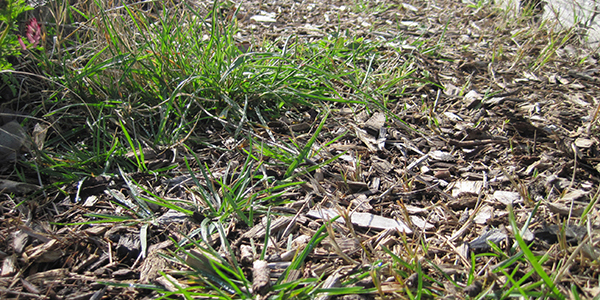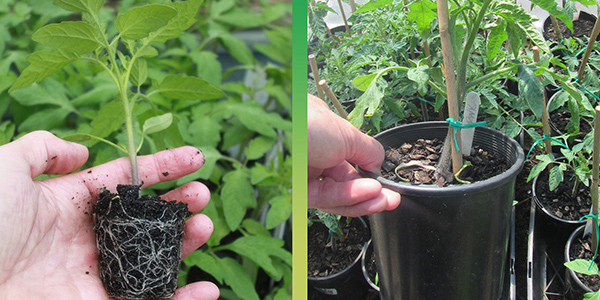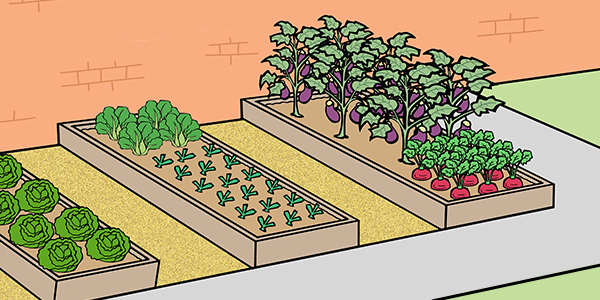How much fertilser should be added to a vegetable bed varies depending on what vegetables are to be grown in it. This page explains the guide that I use to apply fertilser to my vegetable beds.
How much fertiliser should be added to a vegetable bed depends on three things:
- THE VARIETY OF VEGETABLES BEING GROWN
- THE TYPE AND STRENGTH OF THE FERTILISER BEING APPLIED
- THE CURRENT HEALTH OF THE SOIL IN THE VEGETABLE BED
Given these variables it is easy for a gardener to apply either too much or too little fertiliser. This page lists five different standardised fertiliser application rates that I use as my fertilising guideline. But note that every garden has its own soil type and conditions which may require different fertiliser application rates, as such the recommendations below should only be seen as a rough guideline.
terminology used for these application rates
- All amounts listed are for per square metre (m²) of garden bed.
- ANIMAL MANURE refers to sheep, horse and cow manure. If you are using chicken manure than halve the amount as it is very high in nitrogen, but only use well-rotted chicken manure or Dynamic Lifter (compressed pellets of chicken manure with other additives) as fresh chicken manure can burn vegetables.
- LIQUID FERTILISER is diluted liquid fertiliser concentrate such as worm juice (liquid worm castings), Seasol (liquid seaweed), PowerFeed (made from Seasol, fish fertilizer and trace elements), or you can make up your own concentrate by soaking various fertilisers in a drum of water.
- ROCK DUST is powdered rock containing trace elements beneficial to your garden.
- LIME is used to raise the pH of the soil. Dolomite will also raise the pH of soil.
- NPK refers to nitrogen (N), phosphorus (P) and potassium (K). It is a balanced macro-nutrients application used in inorganic gardening. While I do not recommend only using inorganic fertilisers they are listed here as an optional extra low dose supplement. There are more specific inorganic fertilisers, such as potash or urea, but for simplicity I have mainly listed NPK fertiliser.
- All amounts listed are for per square metre (m²) of garden bed.
light feeder vegetables
These are vegetables that need only small amounts of fertiliser to produce a good crop. Vegetables in this group include carrot, beetroot and turnip.
BASIC APPLICATION (m²)
A HANDFUL OF BLOOD AND BONE
- A HANDFUL OF ANIMAL MANURE
- OR NO FERTILISER AT ALL IF THE SOIL IS IN GOOD CONDITION
OPTIONAL EXTRA
PINCH OF ROCK DUST
1/2 A HANDFUL OF NPK FERTILISER
NOTES
Adding animal manures can actually be detrimental to carrots as it can result in split roots. Beetroot that has too much fertilizer applied (especially if it is high in nitrogen) will likely result in plenty of leaves but small beetroots.
Medium feeder vegetables
These are vegetables that need a medium amount of fertiliser to produce a good crop. Vegetables in this group include lettuce, tomato, onion.
BASIC APPLICATION (m²)
SHOVELFUL OF ANIMAL MANURE
SHOVELFUL OF GOOD COMPOST
If you do not have good compost available then replace with a 1/2 shovelful of manure.
HANDFUL OF BLOOD AND BONE
OPTIONAL EXTRA
PINCH OF ROCK DUST
1/3 OF A HANDFUL OF NPK FERTILISER
No more than half the recommended dose on the packet, can be added as extra or used to replace some of the animal manure.
Heavy feeder vegetables
These are vegetables that need a lot of fertiliser to produce a good crop. Vegetables in this group include capsicum, eggplant, potatoes, corn, cucumbers and Asian greens.
BASIC APPLICATION (m²)
SHOVELFUL OF ANIMAL MANURE
SHOVELFUL OF GOOD COMPOST
If you do not have good compost available then replace with 1/2 shovelful of manure.
HANDFUL OF BLOOD AND BONE
- FOLLOW-UP APPLICATIONS OF LIQUID FERTILISER
Apply every one or two weeks, especially when the fruit is maturing.
OPTIONAL EXTRA
PINCH OF ROCK DUST
1/3 OF A HANDFUL OF NPK FERTILISER
No more than half the recommended dose on the packet, can be added as extra or used to replace some of the animal manure.
NOTES
This is the same dose as the application for medium feeders, the difference being you are also regularly applying liquid fertiliser.
alkali soil loving vegetables
These are vegetables that do best in neutral or slightly alkali soil. Vegetables in this group include cabbage, cauliflower, broccoli, Brussels sprouts peas, beans and spinach.
BASIC APPLICATION (m²)
1/2 A SHOVELFUL OF ANIMAL MANURE
SHOVELFUL OF GOOD COMPOST
If you do not have good compost available then leave it out.
TWO HANDFULS OF BLOOD AND BONE
HANDFUL OF LIME (or dolomite)
OPTIONAL EXTRA
PINCH OF ROCK DUST
1/2 A HANDFUL OF NPK OR POTASH FERTILISER
No more than two thirds the recommended dose on the packet, can be added as extra or used to replace some of the animal manure.
FOLLOW-UP APPLICATIONS OF POTASH
Apply by mixing the recommended dose of potash in a watering can and water in. For brassicas, apply two or three times over the life of the plants.
NOTES
The lime is to make the soil more alkali and to counter the acidity of the animal manure, hence the reason for adding less manure. But if you live in an area that has naturally alkali soils you might need to use less lime. Conversely, add more lime if your soil is very acidic. The ideal pH for these vegetables is 7.0 (neutral) or slightly below.
Large spreading vegetables
These are vegetables that have a concentrated root structure with vines spreading outwards. Vegetables in this group include pumpkin and squash.
BASIC APPLICATION (m²)
SHOVELFUL OF ANIMAL MANURE
SHOVELFUL OF GOOD COMPOST
If you do not have good compost available then replace with 1/2 shovelful of manure.
HANDFUL OF BLOOD AND BONE
OPTIONAL EXTRA
PINCH OF ROCK DUST
1/3 HANDFUL OF NPK FERTILISER
No more than half the recommended dose on the packet, can be added as extra or used to replace some of the animal manure.
NOTES
This is the same dose as for medium feeder vegetables, the difference is in how it is applied as it is concentrated directly below the plant rather than spread across the entire bed.
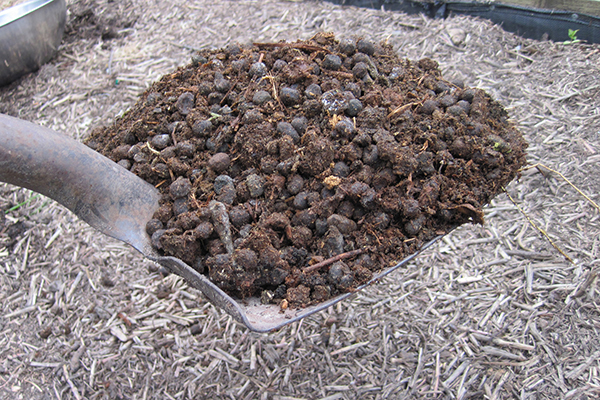
A standard shovelful of manure.
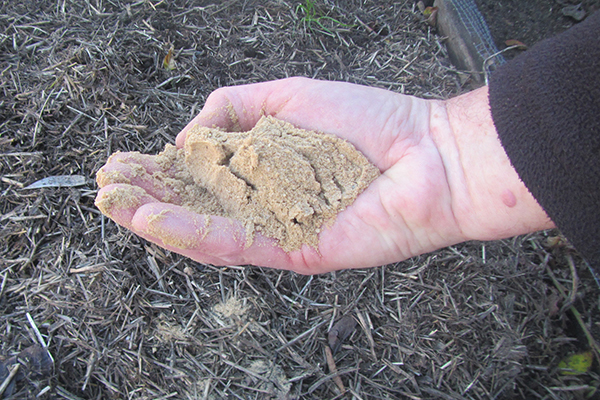
A handful of blood and bone. A “handful” will vary depending on the size of the person’s hand. The general rule of thumb is it should be about 100 grams.
These recommended fertiliser doses should only ever be seen as a rough guideline. Every gardener will have different views of what fertilisers to use, how much to apply and when to apply it. But whatever you use it should be applied in measured doses appropriate to the vegetables being planted. Shovelling fertilisers on haphazardly is not good gardening practice.
Note that other gardening sites lists of which vegetables are in each of the light, medium and heavy feeder categories do vary, these category listings are based on my own experiences. Also note these other sites do not list alkali soil loving vegetables or large spreading vegetables as separate categories, but I have found these categories to be useful.


